Abstract
In order to establish whether vestibular abnormalities often found in spasmodic torticollis are secondary to the abnormal head posture, the vestibulo-ocular reflex (VOR) was studied in eight patients before and after correction of head posture with botulinum toxin. Eye movements were recorded in the dark during sinusoidal and velocity step rotation. Four patients showed a significantly asymmetric response, with the slow phase of the VOR more active ipsilateral to the torticollis (chin). Despite significant improvement of the head posture in all patients for up to 10 weeks following treatment, no correction of the vestibular asymmetry occurred. This suggests that the VOR abnormalities are not caused by the head posture itself. We interpret the findings as evidence of primary involvement of the vestibular system in torticollis and we postulate a widespread derangement of the sensory-motor mechanisms controlling head posture in this disease.
Full text
PDF
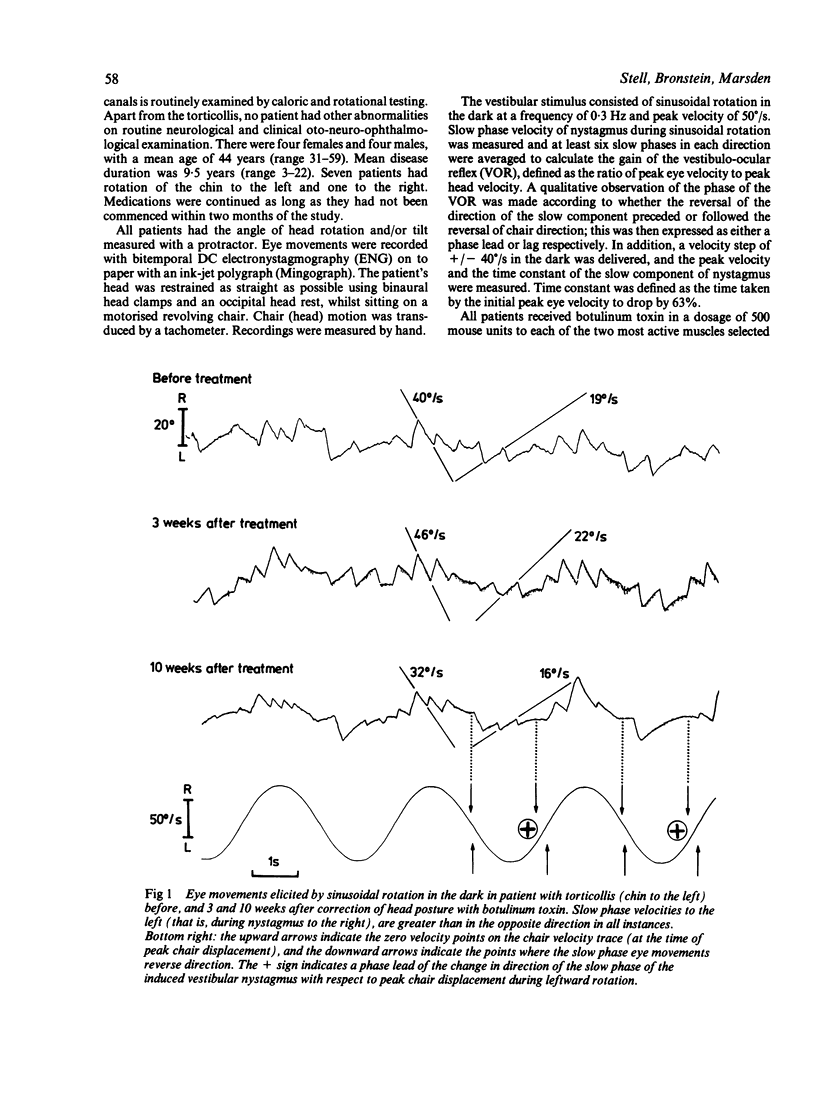
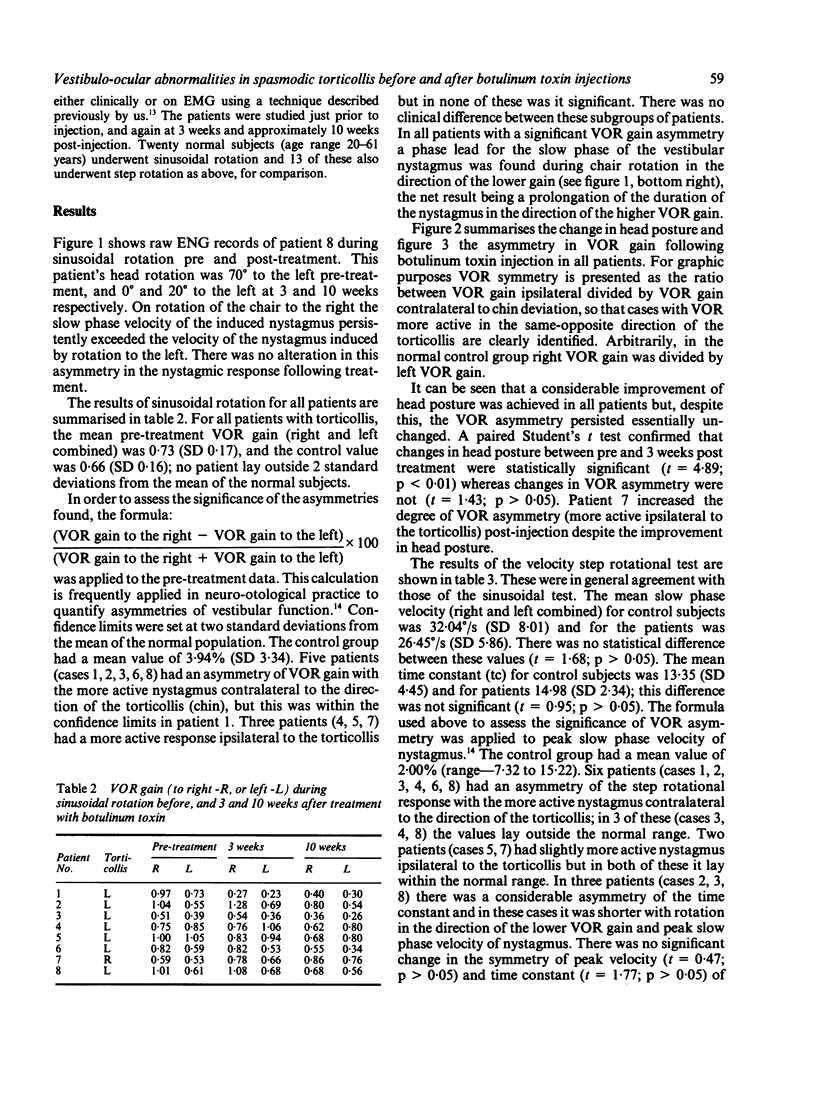
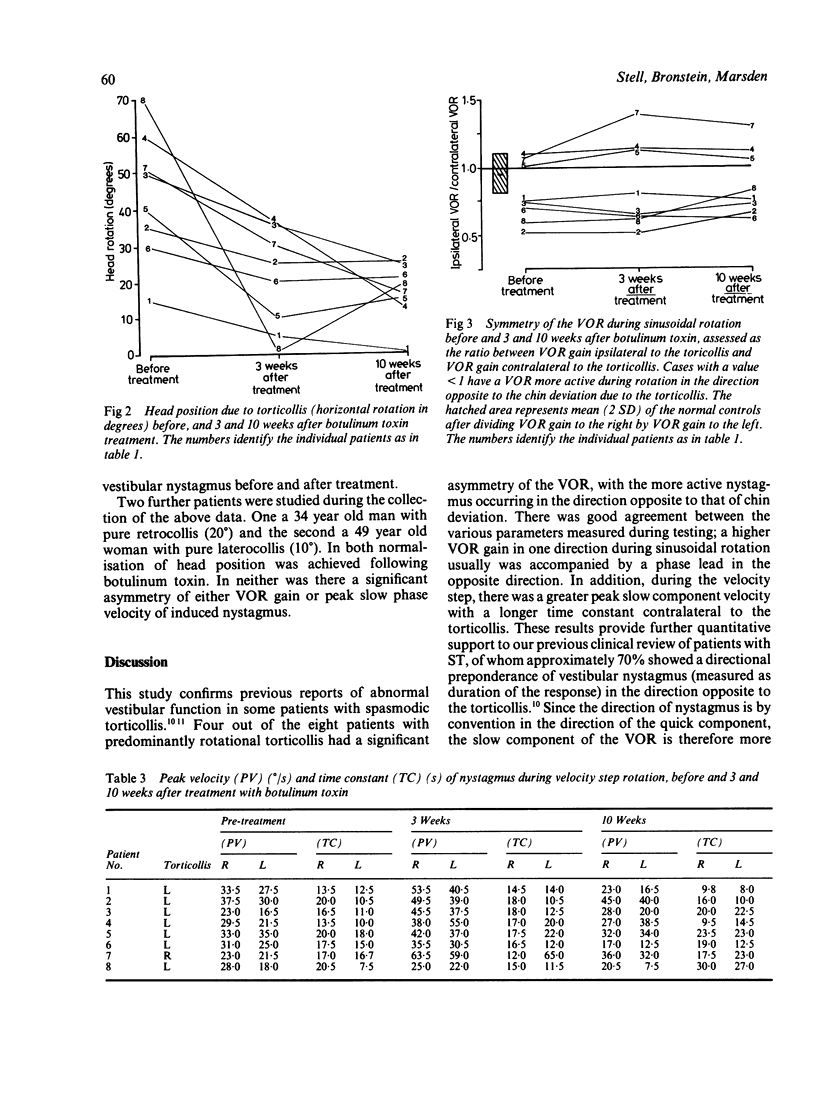
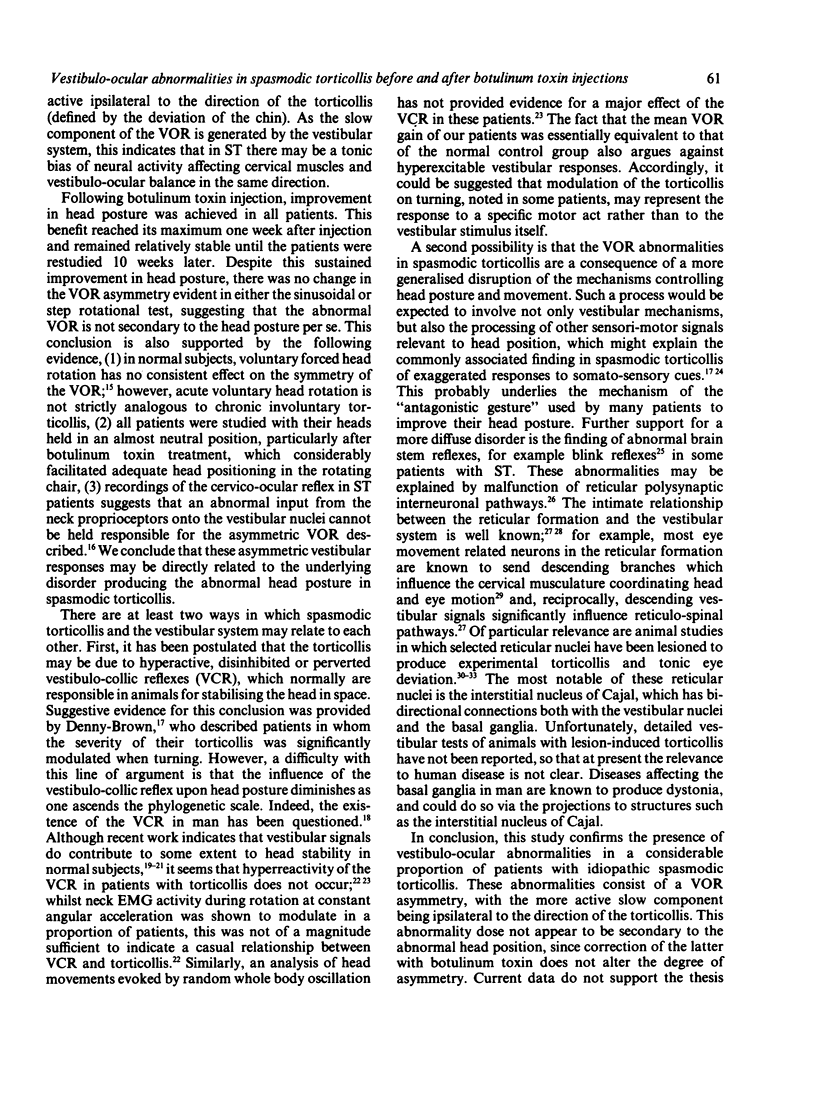
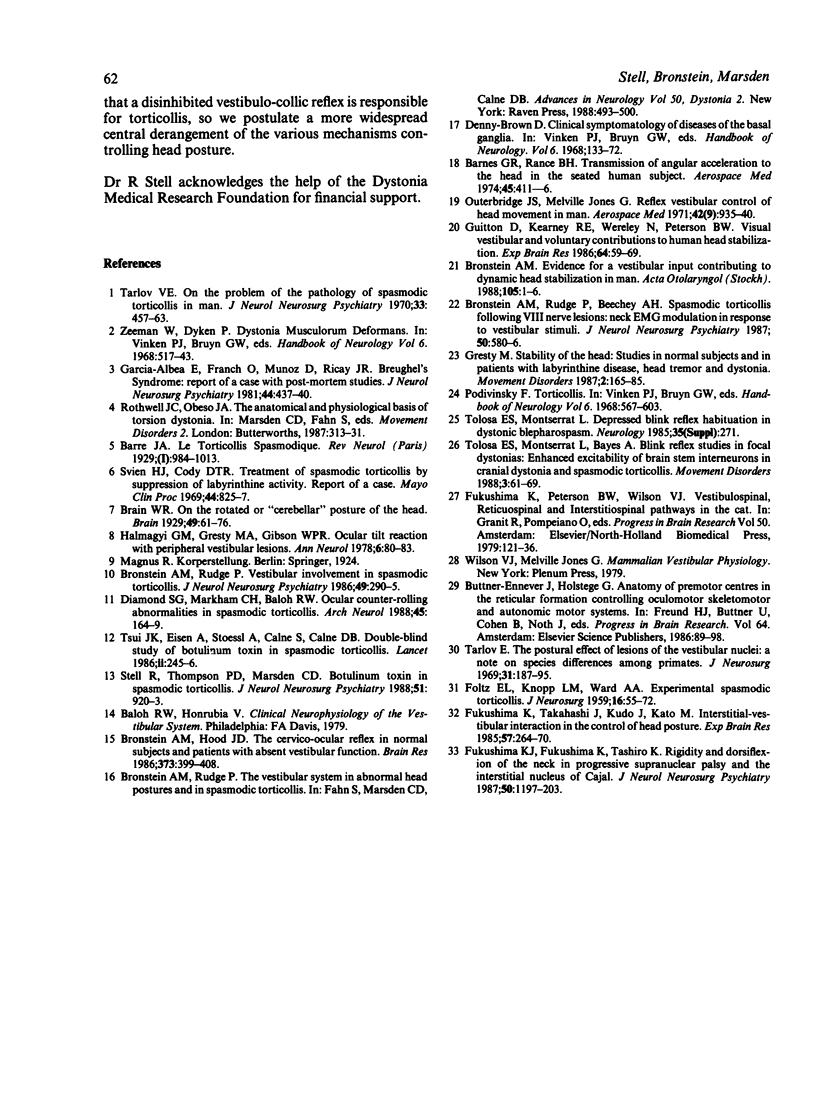
Selected References
These references are in PubMed. This may not be the complete list of references from this article.
- Bronstein A. M., Hood J. D. The cervico-ocular reflex in normal subjects and patients with absent vestibular function. Brain Res. 1986 May 14;373(1-2):399–408. doi: 10.1016/0006-8993(86)90355-0. [DOI] [PubMed] [Google Scholar]
- Bronstein A. M., Rudge P., Beechey A. H. Spasmodic torticollis following unilateral VIII nerve lesions: neck EMG modulation in response to vestibular stimuli. J Neurol Neurosurg Psychiatry. 1987 May;50(5):580–586. doi: 10.1136/jnnp.50.5.580. [DOI] [PMC free article] [PubMed] [Google Scholar]
- Bronstein A. M., Rudge P. Vestibular involvement in spasmodic torticollis. J Neurol Neurosurg Psychiatry. 1986 Mar;49(3):290–295. doi: 10.1136/jnnp.49.3.290. [DOI] [PMC free article] [PubMed] [Google Scholar]
- Büttner-Ennever J., Holstege G. Anatomy of premotor centers in the reticular formation controlling oculomotor, skeletomotor and autonomic motor systems. Prog Brain Res. 1986;64:89–98. doi: 10.1016/s0079-6123(08)63404-4. [DOI] [PubMed] [Google Scholar]
- Diamond S. G., Markham C. H., Baloh R. W. Ocular counterrolling abnormalities in spasmodic torticollis. Arch Neurol. 1988 Feb;45(2):164–169. doi: 10.1001/archneur.1988.00520260050019. [DOI] [PubMed] [Google Scholar]
- FOLTZ E. L., KNOPP L. M., WARD A. A., Jr Experimental spasmodic torticollis. J Neurosurg. 1959 Jan;16(1):55–67. doi: 10.3171/jns.1959.16.1.0055. [DOI] [PubMed] [Google Scholar]
- Fukushima K., Peterson B. W., Wilson V. J. Vestibulospinal, reticulospinal and interstitiospinal pathways in the cat. Prog Brain Res. 1979;50:121–136. doi: 10.1016/S0079-6123(08)60813-4. [DOI] [PubMed] [Google Scholar]
- Fukushima K., Takahashi K., Kudo J., Kato M. Interstitial-vestibular interaction in the control of head posture. Exp Brain Res. 1985;57(2):264–270. doi: 10.1007/BF00236531. [DOI] [PubMed] [Google Scholar]
- García-Albea E., Franch O., Muñoz D., Ricoy J. R. Brueghel's syndrome, report of a case with postmortem studies. J Neurol Neurosurg Psychiatry. 1981 May;44(5):437–440. doi: 10.1136/jnnp.44.5.437. [DOI] [PMC free article] [PubMed] [Google Scholar]
- Gresty M. Stability of the head: studies in normal subjects and in patients with labyrinthine disease, head tremor, and dystonia. Mov Disord. 1987;2(3):165–185. doi: 10.1002/mds.870020304. [DOI] [PubMed] [Google Scholar]
- Guitton D., Kearney R. E., Wereley N., Peterson B. W. Visual, vestibular and voluntary contributions to human head stabilization. Exp Brain Res. 1986;64(1):59–69. doi: 10.1007/BF00238201. [DOI] [PubMed] [Google Scholar]
- Halmagyi G. M., Gresty M. A., Gibson W. P. Ocular tilt reaction with peripheral vestibular lesion. Ann Neurol. 1979 Jul;6(1):80–83. doi: 10.1002/ana.410060122. [DOI] [PubMed] [Google Scholar]
- Outerbridge J. S., Jones G. M. Reflex vestibular control of head movement in man. Aerosp Med. 1971 Sep;42(9):935–940. [PubMed] [Google Scholar]
- Stell R., Thompson P. D., Marsden C. D. Botulinum toxin in spasmodic torticollis. J Neurol Neurosurg Psychiatry. 1988 Jul;51(7):920–923. doi: 10.1136/jnnp.51.7.920. [DOI] [PMC free article] [PubMed] [Google Scholar]
- Svien H. J., Cody D. T. Treatment of spasmodic torticollis by suppression of labyrinthine activity: report of a case. Mayo Clin Proc. 1969 Nov;44(11):825–827. [PubMed] [Google Scholar]
- Tarlov E. On the problem of the pathology of spasmodic torticollis in man. J Neurol Neurosurg Psychiatry. 1970 Aug;33(4):457–463. doi: 10.1136/jnnp.33.4.457. [DOI] [PMC free article] [PubMed] [Google Scholar]
- Tarlov E. The postural effect of lesions of the vestibular nuclei: a note on species differences among primates. J Neurosurg. 1969 Aug;31(2):187–195. doi: 10.3171/jns.1969.31.2.0187. [DOI] [PubMed] [Google Scholar]
- Tolosa E., Montserrat L., Bayes A. Blink reflex studies in focal dystonias: enhanced excitability of brainstem interneurons in cranial dystonia and spasmodic torticollis. Mov Disord. 1988;3(1):61–69. doi: 10.1002/mds.870030108. [DOI] [PubMed] [Google Scholar]
- Tsui J. K., Eisen A., Stoessl A. J., Calne S., Calne D. B. Double-blind study of botulinum toxin in spasmodic torticollis. Lancet. 1986 Aug 2;2(8501):245–247. doi: 10.1016/s0140-6736(86)92070-2. [DOI] [PubMed] [Google Scholar]
- Willer J. C., Barranquero A., Kahn M. F., Sallière D. Pain in sciatica depresses lower limb nociceptive reflexes to sural nerve stimulation. J Neurol Neurosurg Psychiatry. 1987 Jan;50(1):1–5. doi: 10.1136/jnnp.50.1.1. [DOI] [PMC free article] [PubMed] [Google Scholar]


